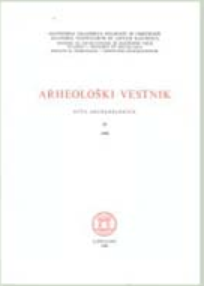Praepositus ripae legionis u natpisima opeka Prve Mezije
Povzetek
Bricks with military stamps from Moesia Prima offer four variants mentioning certain Hermogenes, praepositus ripaelegionis VII Claudiae partis citerioris (above, p. 275—277 ; figs. 1—4). Two of them (nos. 1 and 3), which make possible the complete reading of Hermogenes’ titles, are published here for the first time. These tiles, archaeologically dated to the period between the end of Illrd, and the beginning of Vth, century (the fort at Boljetin, where the most part of them were excavated), actually belong, to judge from the epigraphical indications and historical probability, to the time of important building activity on the Danube under Diocletian and Constantine. The praepositus ripae legionis partis citerioris is not known otherwise but finds his close parallels in the Notitia’s praefecti ripae legionis, who are qualified in a similar way, partis superioris/inferioris (Or. XXXIX 30, 31, 33—35, Scythia; XL 31—35, Moesia Secunda; cf. Occ. XXXIII 51—54, Valeria; XXXIV 38—39, Pannonia Prima; XXXII 44—45, Pannonia Secunda) or even partis mediae (Occ. XXXV 17—19, Raetia). The charge has its antecedents in the praefecti ripae (praefecti orae maritimae, praepositi limitis) of the previous centuries (cf. a praefectus ripae Danuvi in AE 1926, 80), who commanded, as a rule, units whose strength amounted to one cohort approximately. The occurrence of the charge within the Notitia and elsewhere shows a considerable variety depend- ing on local conditions; the general opinion that a pair of the praefecti commanding five cohorts each (downstream and upstream to the legion’s main camp respectively) should be assumed everywhere, is not very plausible. Neither Th. Mommsen’s correction (Ges. Sehr. VI, 222 n. 1) of the Notitia’s ms. reading (praefectus ripae legionis...) cohortis quintae into cohortium quinque seems necessary (the tradition cohortis in Or. XXXIX 35, and tertiae in Occ. XXXIII 54, is significant); it is contradicted by the indications drawn from the earlier history of the institution, and corroborated by the Moesian evidence, on the modest strength of units headed by the praefecti/praepositi ripae. The words partis citerioris stamped on Hermogenes’ tiles probably refer to the Danube and attest to a phase in the history of Legio VII Claudia during which the northern bank of the river -not only the southern one, pars citerior from the Viminacian point of view- was of certain importance. This may be connected to the erection of some transdanubian forts, e. g. Constantia across Margum (most likely Constantinian). Hermogenes’ stamps open a series of the praepositi tile-stamps from Moesia Prima. Epigraphically they are close and the differences among them may have simply resulted, at least in part, from the constant abbreviation, as shown by the representative examples quoted below (for references see notes 48—54) : 1. S. c. Hermogeni pp. ripae leg. VII Cl. part. cit. 2. S. c. Tarae pp. ripae leg. VII Cl. 3. Leg. VII Cl. s. c. Victorini pp. 4. Leg. VII Cl. Tara pp. 5. Leg. VII Cl. s. c. Victorini 6. Leg. VII Cl. s. c. Victorini pp.f(ecit) Vitalianus 7. Leg. VII Cl. s. c. Ursaci p. fiecit) Argutio 8. Leg. VII Cl. Argutio fig(ulus). The links between the types signed by the obviuosly same men (2, 4; 3, 5, 6; 7, 8) even suggest that the whole group must be roughly contemporary, and that these praepositi were officers of equal rank. It could not have been that of the legions’s commander-in-chief (the common reading p{rae)f(ectus) in 6 should obviously be abandoned), as the comparatively high number of names so far known reveals (not counting Hermogenes or Tara, five praepositi of the Legio VII Claudia, four of the Legio //// Flavia). Such a conclusion seems to be supported by a comparable tile-stamp from Dacia Ripensis (SCIU 11, 1960, 337 no. 5: [L(egio) V] M(acedonica). P(rae) p(ositus) c(ohortis) III) where a praepositus of the legions third cohort is explicitly mentioned. As a result, the evidence of the military bricks of Moesia Prima is of a broader interest in two points, which reflect the transformation of the traditional legion into the army of the Later Empire : the parallel and independent appearance of several fractions of the legion, embodied in their praepositi', the connection of those fractions to the ripa legionis. The latter may have had its part in the formation of the milites riparienses.
Prenosi
Prenosi
Objavljeno
Kako citirati
Številka
Rubrike
Licenca

To delo je licencirano pod Creative Commons Priznanje avtorstva-Nekomercialno-Deljenje pod enakimi pogoji 4.0 mednarodno licenco.
Avtorji jamčijo, da je delo njihova avtorska stvaritev, da v njem niso kršene avtorske pravice tretjih oseb ali kake druge pravice. V primeru zahtevkov tretjih oseb se avtorji zavezujejo, da bodo varovali interese založnika ter da bodo povrnili morebitno škodo.
Podrobneje v rubriki: Prispevki





